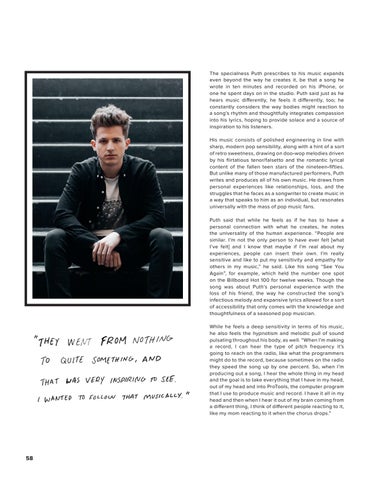The specialness Puth prescribes to his music expands even beyond the way he creates it, be that a song he wrote in ten minutes and recorded on his iPhone, or one he spent days on in the studio. Puth said just as he hears music differently, he feels it differently, too; he constantly considers the way bodies might reaction to a song’s rhythm and thoughtfully integrates compassion into his lyrics, hoping to provide solace and a source of inspiration to his listeners. His music consists of polished engineering in line with sharp, modern pop sensibility, along with a hint of a sort of retro sweetness, drawing on doo-wop melodies driven by his flirtatious tenor/falsetto and the romantic lyrical content of the fallen teen stars of the nineteen-fifties. But unlike many of those manufactured performers, Puth writes and produces all of his own music. He draws from personal experiences like relationships, loss, and the struggles that he faces as a songwriter to create music in a way that speaks to him as an individual, but resonates universally with the mass of pop music fans. Puth said that while he feels as if he has to have a personal connection with what he creates, he notes the universality of the human experience. “People are similar. I’m not the only person to have ever felt [what I’ve felt] and I know that maybe if I’m real about my experiences, people can insert their own. I’m really sensitive and like to put my sensitivity and empathy for others in my music,” he said. Like his song “See You Again”, for example, which held the number one spot on the Billboard Hot 100 for twelve weeks. Though the song was about Puth’s personal experience with the loss of his friend, the way he constructed the song’s infectious melody and expansive lyrics allowed for a sort of accessibility that only comes with the knowledge and thoughtfulness of a seasoned pop musician. While he feels a deep sensitivity in terms of his music, he also feels the hypnotism and melodic pull of sound pulsating throughout his body, as well. “When I’m making a record, I can hear the type of pitch frequency it’s going to reach on the radio, like what the programmers might do to the record, because sometimes on the radio they speed the song up by one percent. So, when I’m producing out a song, I hear the whole thing in my head and the goal is to take everything that I have in my head, out of my head and into ProTools, the computer program that I use to produce music and record. I have it all in my head and then when I hear it out of my brain coming from a different thing, I think of different people reacting to it, like my mom reacting to it when the chorus drops.”
58

